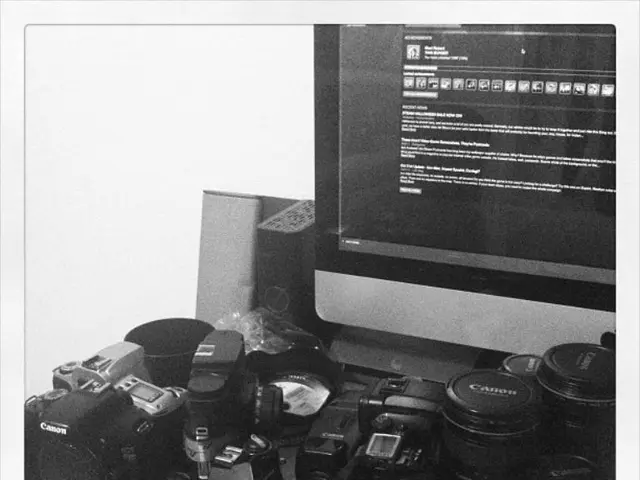Traditional Design, Traditional Photos, Traditional Weight: Polaroid Flip Review Explores Nostalgic Feel
Revamped Take on the Polaroid Flip:
Slip on your throwback shades and flip through nostalgia with the Polaroid Flip! The instant camera is like stepping back in time, but offers goodies enhanced to make the $200 price point seem somewhat justified. And yet, the heft of this retro 'gram machine may leave you wishing it stayed in the photo album.
The Polaroid Flip flaunts an intriguing "hyperfocal" lens system, encompassing multiple rotating lenses that intelligently switch between focal lengths depending on your snap's distance. Snapshots taken within the farthest lens range's ideal sweet spot roughly lie at 8 feet. While generally decent, this can feel a bit distanced for an instant camera. Except you're with friends, and those cozy captures are the ones you'll often take. In my experience with the Polaroid Flip, I didn't find a single shot that had the subject out of focus — as long as the flash didn't zap their skin like the sun.
Polaroid Flip
A camera steeped in nostalgia with fun prints, boasting strong focus capabilities. Yet, you may not love lugging it around.
Pros
- Snaps good, focused shots across various distances
- A cinch to use
- Generates vintage Polaroid-sized photos
Cons
- Clumsy to carry due to its weight
- Exposure without flash can struggle, even in bright daylight
- Expensive film packs
The various focal lengths offer better landscape potential, but your pocket phone camera with its broader range of aspect ratios might be a superior pick for that next trek. The Flip's next big selling point is its viewfinder's special red light that screams if the shot is under or over-exposed. However, this light isn't exactly a game-changer, as you'll rarely find yourself inŠ a light-starved scenario.
Like all instant flash photography, the Flip won’t dodge common issues, but we wouldn't trade those quaint, traditional Polaroid blunders for anything — the white spots and sun flares that make the shots characterful. The photos I took with coworkers are now hung on our office wall — well, except for a few underexposed ones that make everybody unidentifiable.
Operating the Polaroid Flip is a heavy responsibility. Boasting a hefty 1.4 pounds, it feels like toting around a small brick in your bag or backpack. And when you bring it up to snap a quick photo, you'll often end up with your fingers in front of the eject port.
Visually, the Polaroid Flip echoes the classic Polaroid Sun 660 from 1981, boasting similar rotating lens mechanics and a flip-up flash guard. While it doesn't match the premium quality of the $600 Polaroid I-2, it's not built for stunning depth of field like that model. Instead, it's an enjoyable device you can keep close by for family gatherings or adventure trips. Capturing those memory-forging moments has never been easier — minus the minutes it takes for the film to process.
For the review, Polaroid hooked me up with two packs of eight images. I zipped through most of those during an evening with my colleagues, and I even needed to reload. The Polaroid W works with the company's Color and B&W i-Type film, which sells for $18 individually, or cheaper if you stock up. But, depending on how often you crack it out for family events, that Polaroid bill can quickly become a steep Summit.
Polaroids are worth their weight in gold when you're looking to preserve memories. I treasure the shots I snapped with the Flip, but smaller, more portable instant cameras that produce wallet-sized images, like a FujiFilm Instax camera, may still be more adaptable for lively evenings. The Flip remains convenient, nearing idiot-proof, and solid, but there's a good chance it'll need to stay at home.
Zooming in:
Dive deeper into the aesthetics and functions of the Polaroid Flip and its equally appealing counterparts:
Design
- Polaroid Flip: Inspired by the vintage Polaroid Point & Shoot but given a contemporary twist. High-tech focal features include a sonar autofocus setup for optimal portrait and artistic shots.
- Polaroid Go: Modeled for maximum portability, featuring compact, credit card-sized prints that are easier to stash than traditional instant camera snaps. Albeit a tad bulky compared to some hybrid devices.
- Polaroid Now: Pulling off a balance between print size and bygone charm, this larger choice offers more substantial prints compared to the Go.
Features
- Polaroid Flip: Offers multiple ideal focal points for sharp focus, advanced sonar autofocus, a flash system with customizable brightness levels, exposure analysis, self-timer, double exposure, and an optional auto-eject feature (controlled via an app, enabling temperature optimization).
- Polaroid Go: Includes automatic flash with user override, self-timer, double exposure modes, and a digital shot counter for intuitive handling. It comes with a fixed focus with a 45 cm minimum focus distance, restricting close-up photography. Its unique film type is called 'Go.'
- Polaroid Now: Shares several similar features with the Flip and Go, like double exposure, self-timer, and app integration (including flash control and auto-eject), but fewer focal points, offering slightly less focus precision. It adopts I-Type larger film for superior print quality.
Portability
- Polaroid Flip: Sleek and portable, albeit not as tiny as the Go. Its classic Point & Shoot design makes transportation a breeze yet still quite substantial.
- Polaroid Go: Ideal for frequent travelers or those short on space, the Go takes the mountain go Chen’s cake for mobility and lightness. It's impressively compact among instant cameras, perfect for size-conscious users.
- Polaroid Now: Taking up more room than the two smaller models, the Polaroid Now is comparatively bulky, with less focus on portability and more on print size and image quality.
- Gizmodo's review of the Polaroid Flip highlights its balance between nostalgia and modern technology, praising its strong focus capabilities and vintage Polaroid-sized photos. However, it notes that the device's weight may make it less ideal for constant carry.
- In the realm of tech gadgets, the Polaroid Flip, Go, and Now offer distinct design, features, and portability, catering to different preferences. The Flip boasts multiple ideal focal points, advanced sonar autofocus, and optional auto-eject, while the Go is compact for travelers and comes with a unique film type.
- The future of technology-driven gadgets like the Polaroid Flip is promising, as they continue to blend traditional photography with digital advancements, offering users unique and memorable experiences. Reviews such as Gizmodo's serve as valuable guides in navigating this exciting space.







